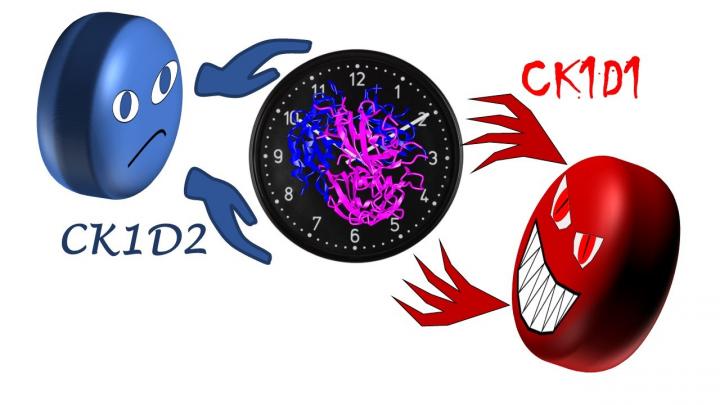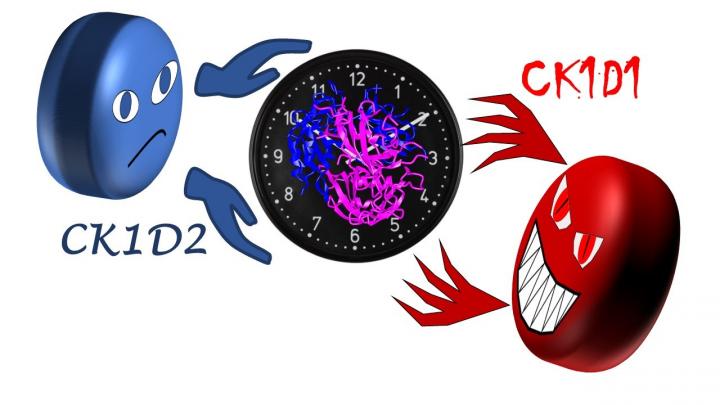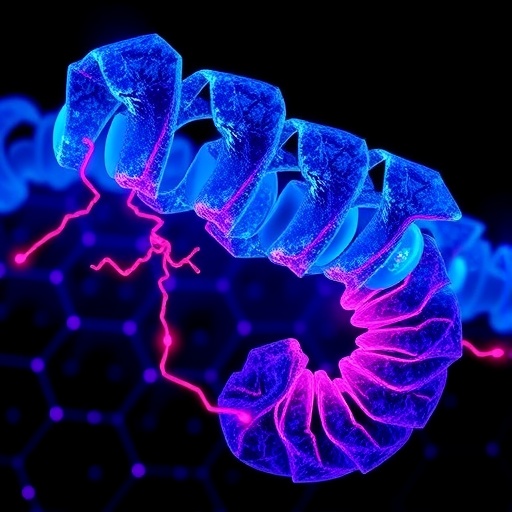
Credit: Kyoto University / Jean-Michel Fustin
Kyoto, Japan — A long-studied factor controlling human sleep cycles actually has two forms, one that keeps a key protein stable and another that promotes its degradation.
From the heart and lungs that propel our blood, to our rumbling stomachs at lunch time and feeling of tiredness in the evening, our bodies keep steady rhythms day in and day out.
This 'circadian clock' is a series of tightly controlled cycles of specific amounts of proteins that make us either sleepy or wakeful. It has recently attracted public attention with the 2017 Nobel Prize for Physiology or Medicine, but numerous aspects of the clock's functions or how it regulates our health remain a mystery.
One of the first circadian rhythm sleep disorders to be discovered was Familial Advanced Sleep Phase Syndrome, or FASPS. Patients with this condition fall asleep early in the evening, around 7 pm, and wake up in the early mornings, around 3 am, and are thus unable to adjust to standard cycles without undergoing treatment.
"FASPS is characterized by a mutation in the gene that codes for a protein essential for the circadian clock, called Period 2, or PER2," explains corresponding author Jean-Michel Fustin from Kyoto University's Graduate School of Pharmaceutical Science. "The stability of the PER2 protein is a key factor in determining how fast your circadian clock ticks."
In FASPS patients, PER2 is unstable, resulting in a sped-up clock. This is due to a mutation that changes one amino acid in the protein from a serine to a glycine.
"The stability of PER2 is regulated by the phosphorylation of several critical amino acids — a common way proteins are regulated in the body. This process is conducted by other proteins called kinases," continues Fustin. "We knew of a kinase that could destabilize PER2 — Casein kinase 1 delta, or CK1D — but we couldn't find one that could stabilize it by phosphorylating the serine that is mutated in FASPS patients."
Writing in PNAS, Fustin and his collaborators explain that the stabilizing kinase was within the Ck1d gene itself all along. Their findings show that in addition to destabilizing PER2, Ck1d has another form, one that does the exact opposite.
While structurally very similar, these two kinase forms are named CK1D1 and CK1D2.
"The opposite activity of CK1D2 was completely unexpected. These two versions of this kinase can be likened to the kind Dr Jekyll — CK1D2 — and the destroyer Mr Hyde — CK1D1," states Fustin. "While in many cases the same gene can code for different proteins, such a stark difference in function is rare."
"Circadian clock mechanisms can be found in bacteria, insects, plants, and vertebrates. Understanding these fundamental mechanisms allows us to understand our relationship with the rhythmic environment," concludes co-corresponding author Hitoshi Okamura. "Our discoveries indicate that the circadian clock can be adjusted between these kinases, and provides new targets for the treatment of circadian disorders."
###
The paper "Two Ck1δ transcripts regulated by m6A methylation code for two antagonistic kinases in the control of the circadian clock" appeared 21 May 2018 in Proceedings of the National Academy of Sciences of the United States of America, with doi: 10.1073/pnas.1721371115; it is accompanied by a second paper "CK1δ/ε protein kinase primes the PER2 circadian phosphoswitch" appearing in the same journal (10.1073/pnas.1721076115). These discoveries were made jointly with a team from Duke-NUS Medical School in Singapore, led by David M Virshup.
About Kyoto University
Kyoto University is one of Japan and Asia's premier research institutions, founded in 1897 and responsible for producing numerous Nobel laureates and winners of other prestigious international prizes. A broad curriculum across the arts and sciences at both undergraduate and graduate levels is complemented by numerous research centers, as well as facilities and offices around Japan and the world. For more information please see: http://www.kyoto-u.ac.jp/en
Media Contact
Raymond Kunikane Terhune
[email protected]
81-757-535-728
@KyotoU_News
http://www.kyoto-u.ac.jp/en
Related Journal Article
http://dx.doi.org/10.1073/pnas.1721371115





